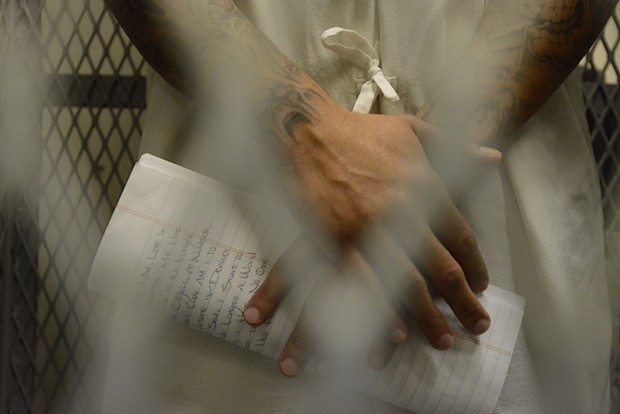News Blog

- Mark McKenna
1. Several Humboldt residents and programs bring classes to prisoners in both general population and solitary confinement at Pelican Bay State Prison as part of the state's Arts in Corrections Programs. Those classes include theater, guitar and drawing. We shadowed Cecelia Holland, a Fortuna author who teaches creative writing. Holland originally got involved with the program during the 1990s but had to stop when the program ended in 2003.
2. There were no arts classes for solitary confinement inmates prior to 2014. Better programming for prisoners in the Secure Housing Unit (known as the SHU) was one of the demands of a hunger strike staged in 2011, along to an end to indefinite confinement. Now those inmates have access to many different programs, including one on entrepreneurship and another with peer-led counseling. Holland says she enjoys working with her SHU students, who are among the most creative and hard-working writers she teaches.
3. Getting SHU students to class is an intensive process. In order to get to the class, solitary confinement inmates have to be processed out of their cells (where they stay, alone, up to 22 hours a day) and have their hands handcuffed behind their backs then shackled to their waists. They are then escorted by two guards to the classroom, where they are put in cages just tall enough to stand in. This process is repeated one prisoner at a time to make up the six-person class. The amount of staffing necessary to do this can impact the availability of classes.
4. Students often write about prison. Although Holland says some of the inmates write about experiences totally foreign to their own (one, who she calls "a little hood rat" writes work that should be in The New Yorker, Holland says), much of what makes its way into their fiction is about the events that led up to incarceration or daily life within the prison. In contrast, the arts teacher, Julie McNiel, says her students often draw pictures of the outside world, often nature scenes.
5. Holland says her students bond more easily with her because she doesn't work for the correctional system. The 74-year-old author of more than 40 historical novels has a rapport with her students that comes from their shared disdain for authority, she claims. "When I meet a group of new guys, I usually tell them, 'There's really only one question in the world, which is, 'What the fuck?'," says Holland.
Linda Stansberry is a staff writer at the Journal. Reach her at 442-1400, extension 317, or [email protected]. Follow her on Twitter @LCStansberry.

Comments